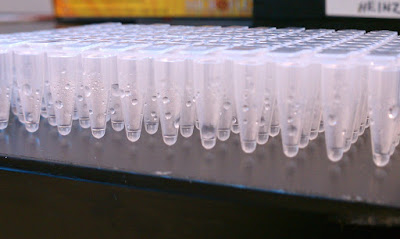Due to an apparent reduction in assay sensitivity for the Hematodidium qPCR assay, we have decided to determine if the spec readings of the plasmid DNA being used for the standard curves are accurate. Used C.gigas gDNA and the lambda DNA Standard (100ng/uL) included in the Quant-iT PicoGreen dsDNA Assay Kit (Invitrogen) that was marked as received 9/1/10. Tested both the Roberts Lab and Young Lab using these DNAs. At least 6 separate measurements were taken of each DNA on each machine. Samples were briefly mixed by flicking the tube 4-5 times prior to each measurement.
Results:
A quick table of the results:
| Roberts Lab | Young Lab | |
| [Avg. gDNA] (ng/uL) | 45.656 | 51.778 |
| Std Dev gDNA | 0.2377 | 0.5825 |
| [Avg. lambda DNA] (ng/uL) | 76.01 | 90.255 |
| Std Dev lambda DNA | 3.826 | 0.9342 |
The first thing to notice is that the lambda DNA that has been used for standard curves does not have the expected concentration (100ng/uL) on either of the machines. It seems unlikely that BOTH NanoDrop1000s are incorrectly calibrated (which could be a possible explanation for why the lambda DNA is not matching the expected 100ng/uL). This is also supported by recent curves done on the Friedman Lab plate reader using this DNA by Lisa, Vanessa and Elene (data not shown). It’s also interesting to note that the lambda DNA also shows a greater standard deviation (on both machines) than the other DNA (gDNA) used in this test. This is surprising as one would expect a store-bought reagent to be of the highest quality, particularly since it is supposed to be used for DNA quantification. However, it should also be remembered that this DNA is over a year old and has never been aliquoted. As such, it has gone through an extremely high number of freeze/thaw cycles which could have an impact on the long-term quality of the DNA.
The second thing to notice is that the Roberts Lab and Young Lab machines provide different concentrations of each of the two DNAs. Unfortunately, due to the fact that the lambda DNA concentration is not as expected (100ng/uL) on either machine it is impossible to determine which machine is more accurate. However, it appears that the Young Lab NanoDrop1000, overall, is more consistently precise in its readings than the Roberts Lab NanoDrop1000. Of course, both machines do seem to be sufficiently precise that precision shouldn’t be a concern.
I’ve notified Lisa of the potentially inaccurate readings of the lambda DNA. She has ordered a fresh set of DNA standards that will be used to test both machines to help assess their accuracy.


